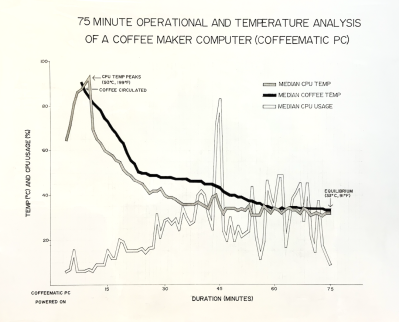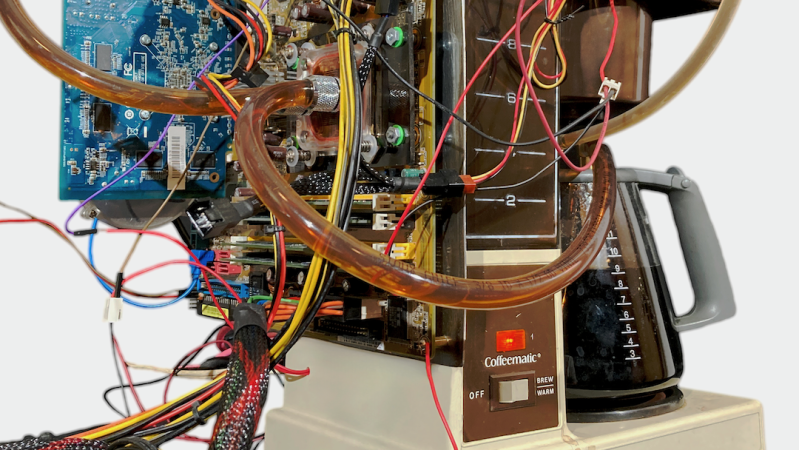Modern computers generate a great deal of heat when under load, thus we cool them with fans and sometimes even water cooling systems. [Doug MacDowell] figured that water was alright, but why not use coffee instead?

The coffee maker percolates coffee as per normal into the carafe, and from there, it’s then pumped through two radiators on top of the PC. From there, it circulates to the water block on top of the CPU, and then back to the carafe on the coffee maker where the cycle repeats. Doug notes the coffee is initially so hot (90 C) that the PC is at risk of crashing, but after 75 minutes circulating through the system, the coffee and CPU sit at an equilibrium temperature of 33 C.
You can’t really drink coffee from this machine. PC water cooling components are not food safe in any way, and [Doug] notes mold will become an issue over time. For short periods at least, though, it’s possible to sort-of-cool your computer with hot, fresh coffee if you really want to do that.
We’ve featured some great hacks of conventional coffee machines over the years, including this fantastic talk at Supercon 2023.















Awesome! Can’t wait for the Halloween build! 😃
“You can’t really drink coffee from this machine. PC water cooling components are not food safe in any way…”
However, if you included a food-safe heat exchanger, you could drink the coffee. C’mon, folks, this stuff is both necessary and getting expensive, no need to waste good coffee.
Coffee is slightly acidic and that’s what make it difficult to make food grade heat exchanger.
In case we needed another meme engineering project to deplete our planet’s ressources faster
I get the appeal of building for building’s sake but at some point it becomes unethical
It’s counterproductive to shame such a miniscule uses of energy. It gives the false impression that saving the environment requires giving up all joy.
Transportation and climate control make up such a large fraction of our energy usage that talking about coffee makes is a distraction.
If you drive alone in a car at some point this week then you’ve committed an environmental sin 100x larger.
If you’ve flown on an airplane this year, it’s 1,000x.
Meh.. needlessly adding to a problem is not something to be celebrated just as much as micro-managing solutions to macro problems. The idea that ‘if you drove a car .. ‘ etc is a false analogy right from the start as most people find transportation necessary where a project like this is necessary to no one.
Expressing creativity, curiosity, joy, and delight is a necessary part of life.
Must have forgotten about those walking sticks attached to your sitting bones
I guess we shall stop all activities that are not essential to the continuation of the human race? Because doing something fun for the sake of fun with spare resources that would have just been waste anyways is no longer allowed.
You better not EVER play videogames, watch TV, or browse social media, or you’re a hypocrite
Art is a waste of resources too!
We should all live in Soviet blocks, wear uniforms and only think things pooh bear has written down for us to think!
The biggest waste of resources?
hipho’s life!
I know an air thief when I hear his/her ‘thoughts’.
Save the planet…yourself!
That said, this is a stupid use of time and money.
But it’s his time and money to waste.
w ragebait bro
Coffee is acidic, and probably gets even more acidic as it continues to degrade and oxidize in a cooling loop. Cool project but watch out for degradation.
Nah, the aluminum heat sinks react with the acids. After a week there will be a good thick layer of aluminum oxide. The aluminum deposited in your brain might be another matter.
Depends if there are some spots that are not being constantly flushed and local deposits start forming. Good start for pitting corrosion.
How about using the cooling system to preheat the water to brew the coffee? Ok, you may end up with more coffee than needed, but is that really a problem?
You could heatpump it up to 90°C!
Only problem: Coders need coffee to start work
Coffee makers need coders to work befor they start making coffee.
Struggling with brain fog this morning, but I was thinking something similar. A combination of heat pump(s?) and exchanger(s?) ought to be able to both cool a PC and heat water/tea/coffee. Maybe throw in some peltiers to power LEDs based on the heat delta, and you might be able to make the least efficient PC cooler/water warmer possible.
Wasn’t that the normal operation temperatur of the Prescott?
I don’t quite understand why this was done, but I’m glad somebody did it.
I want to know how that plot is made ! Its SO cool !
Originally, they would have made it by using pens and masking tape on a piece of heavy card stock. Then you’d photograph it and reduce it for printing. The text and the font is produced by a kind of stencil. Here’s a film of a Leroy lettering kit being used:
https://www.youtube.com/watch?v=GZRvQDMBEOE
Thanks PlotLover. It took a very long time. Here’s a quick breakdown:
I plotted a grid in graphite and marked the data point. To create the lines in the graph I used a circle template for each data point (for consistent line width) then connected the edges of the circles with a ruler. I used ink on top of the graphite, and then used a vintage lettering kit (like the one @Dude shared in the link) to do the lettering.
At the very end you use an eraser to remove all the graphite, and you’re left with the most satisfying clean ink line you can imagine :)
I’ve done more hand drawn dataviz if you want to check them out: https://www.dougmacdowell.com/data-landscapes.html
I figured you were using fine line masking tape and drawing along the edge of the tape, then peeling the tape off to leave an exact 1/8″ or 1/16″ double line.
If you were doing a photo exposure process or a xerox copy, the lighter graphite lines would vanish automatically by blowing out the contrast. To make it more reliable, you’d use colored graphite pens, magenta or blue, which are easy to see by eye and easily filtered out in the developing process.
Interesting techniques – thanks for sharing. Leaving some evidence of the graphite lines was on purpose (a clue that the graph was made by hand).
Sounds like you might be a draftsman?
As other commenters have mentioned, you could create a version of this that actually brews drinkable coffee using the computer itself. All you need to add is a food-safe heat exchanger (stainless-steel flat plate heat exchangers are a good option). Then allow the CPU to heat the cooling loop to its maximum thermal throttling temperature. You might have to tweak a bios setting or even carefully select a CPU for optimal coffee brewing temp – not all CPUs will be configured to reach the 90-95c that many brewing methods require.
Also, if you want your coffee in a hurry, even the most power-hungry CPU is only going to be able to deliver a few hundred sustained watts, which is pretty disappointing. Unless you’re building a multi-processor coffee server, you’ll probably want to add a water-cooled GPU to the loop for rapid heating. Nvidia’s flagship models like the RTX 5090 and 4090 are excellent options as they can draw almost as much power as a standard coffeemaker, but the budget-conscious could build a nice, vintage-inspired multi-gpu system using, say, four GTX 1080s in order to achieve coffee SLI. AMD’s latest GPUs are also a viable option, while their decade-old RTX 480 series is very affordable and notoriously power hungry.
(I have some relevant experience, believe it or not, as about ten years ago I built a water-cooled PC that could keep a hot tub at a nice soaking temperature. Never documented the build, but it worked remarkably well. Of course it used a heat exchanger to keep the hot tub water isolated from the PC.)
Love this. The opportunities for upgrades seems limitless thanks to a community of thinkers like this.
There are better uses of coffee than cooling a CPU.
On the other hand, when someone asks “does your computer run Java” you can say “Not only does it run Java, it runs ON Java!”
+1
Need a way to get the caffeine from the coffee into the CPU, thus overclocking it.
I hope that in some microscopic way the caffeine is finding its way to the cpu. How to test this? I have no idea …
I’m sorely disappointed that nobody has yet suggested running a nice hot cup of tea through this thing to create a finite improbability generator. Of course, you would also have to swap out the motherboard for the logic circuits of a Bambleweeny 57 Sub-Meson Brain connected to an atomic vector plotter, but I’m sure that would be a trivial upgrade.
R.I.P. Douglas Adams
Can the computer go into sleep mode with all that coffee?
Why not start with cold brew coffee and add a refrigerator to keep it cold?
Neat, but we need food grade components to brew coffee.
Based on the color of this liquide, it would only quality as coffee in USA, UK or Russia…